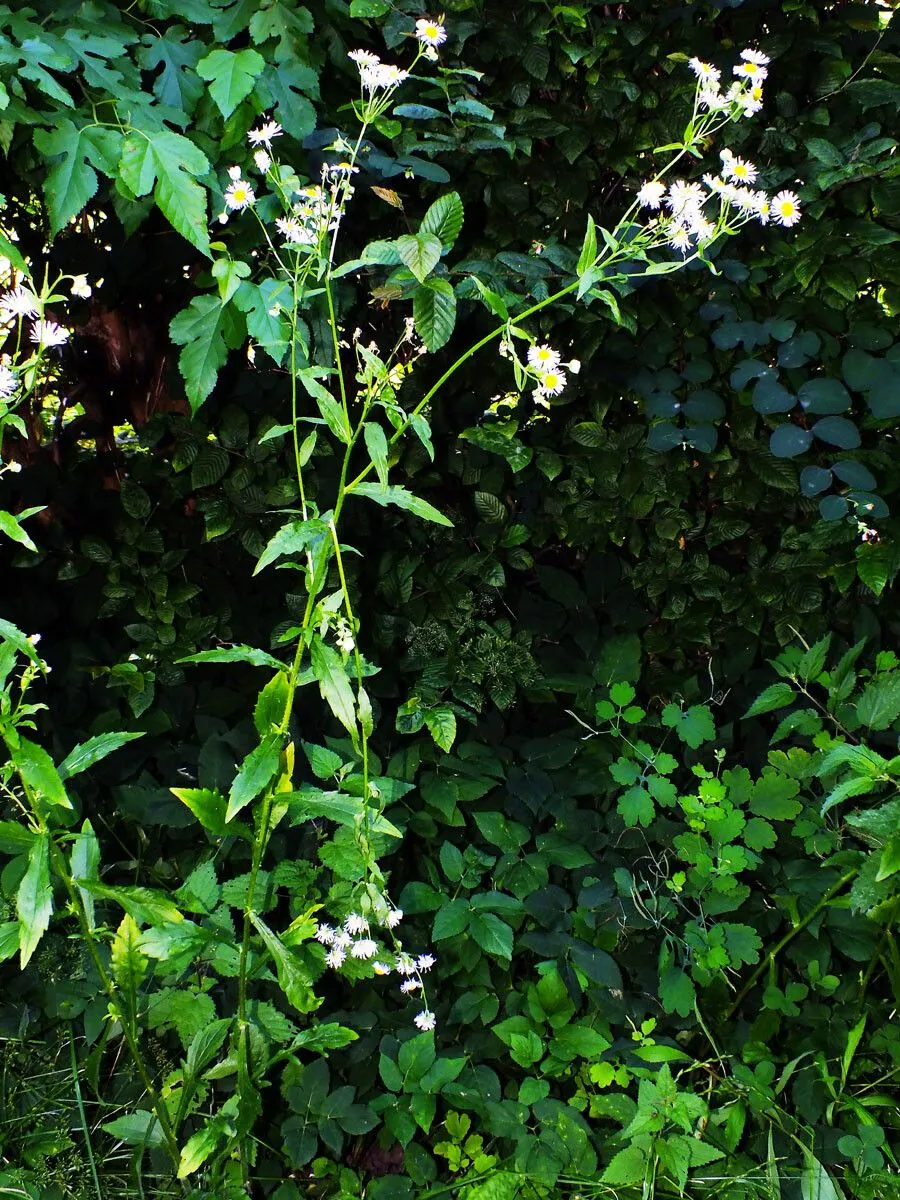
Author: (L.) Pers.
Bibliography: Syn. Pl. 2(2): 431 (1807)
Year: 1807
Status: accepted
Rank: species
Genus: Erigeron
Vegetable: False
Observations: Canada to U.S.A., Nicaragua to Panama
Daisy fleabane, scientifically known as Erigeron annuus, is a captivating member of the Asteraceae family. This charming plant has carved its niche across North and Central America, gracing landscapes from the vast expanses of Canada and the diverse terrains of the United States to the tropical regions stretching between Nicaragua and Panama.
Characterized by its delicate and intricate bloom, the Daisy fleabane presents a cheerful visage with its small white petals radiating around a central yellow disc. The beauty of this plant lies not only in its aesthetic appeal but also in its versatility and hardiness, thriving in a wide array of habitats.
Historically documented in 1807 within the volume Syn. Pl. 2(2): 431, by the botanist (L.) Pers., Daisy fleabane has since been cherished for its ornamental value and its occasional use in folk medicine. The plant’s proliferation across such extensive and varied geographical areas speaks to its adaptability and resilience, making it a common and beloved sight in both wild and cultivated settings.
Erigeron annuus plays a valuable role within its ecosystem. It attracts a plethora of pollinators, including bees and butterflies, thereby supporting the intricate web of biodiversity. Gardeners and nature enthusiasts alike appreciate this plant for its contribution to ecological health and its gentle presence in gardens and natural areas.
In summary, Daisy fleabane is a testament to botanical beauty and biological endurance. Its widespread presence from Canada to Panama is a clear indicator of its ecological significance and the joy it brings to countless plant admirers across its range.
Eng: annual fleabane, daisy fleabane, eastern daisy fleabane, sweet-scabious, tall fleabane, whitetop, strigose fleabane, sweet scabious, white-top, whitetop fleabane
Deu: einjähriger feinstrahl, einjähriges berufkraut, feinstrahl
Swe: sommarbinka, sädekallioinen
Fin: sädekallioinen
Nob: trådstjerne
Nno: trådstjerne
Fra: vergerette annuelle, sténactis à feuilles larges, érigéron annuel
Nld: zomerfijnstraal
Cym: amrhydlwyd tal
En: Daisy fleabane, Tall fleabane, Annual fleabane, Eastern daisy fleabane, Sweet-scabious, Whitetop, Strigose Fleabane, Sweet scabious, White-top, Whitetop fleabane
Ar: أريغارون حولي
Az: Birillik xırdaləçək
Be: Танкалучнік аднагадовы
Bg: Бяла злолетница
Zh: 一年蓬, 白頂飛蓬
Hr: Jednogodišnja krasolika
Cs: Turan roční pravý
Da: Smalstråle
Nl: Zomerfijnstraal
Et: Üheaastane õnnehein
Fi: Sädekallioinen
Fr: Vergerette annuelle, Sténactis à feuilles larges, Érigéron annuel
De: Einjähriger Feinstrahl, Feinstrahl-Berufkraut, Einjähriges Berufkraut, Feinstrahl
Hu: Egynyári seprence
It: Céspica annua, Cespica annua
Ko: 개망초
Lt: Vienmetė šiušelė
Nb: Trådstjerne
Nn: Trådstjerne
Pl: Przymiotno białe
Ru: Мелколепестник однолетний
Sr: Красолика
Sk: Hviezdnik ročný
Sv: Sommarbinka, Sädekallioinen
Zh-tw: 白頂飛蓬
Zh-hant: 一年蓬
Tr: Hemşin şifaotu
Cy: Amrhydlwyd tal
© copyright of the Board of Trustees of the Royal Botanic Gardens, Kew.
© copyright of the Board of Trustees of the Royal Botanic Gardens, Kew.
© copyright of the Board of Trustees of the Royal Botanic Gardens, Kew.
Taken Jul 5, 2014 by Andrzej Konstantynowicz (cc-by-sa)
Taken Jul 5, 2014 by Andrzej Konstantynowicz (cc-by-sa)
Taken Jul 5, 2014 by Andrzej Konstantynowicz (cc-by-sa)
Taken Oct 13, 2019 by Indola (cc-by-sa)
Taken May 31, 2020 by ty shahan (cc-by-sa)
Taken Jul 23, 2021 by Jacques Zuber (cc-by-sa)
Taken Jul 24, 2021 by Christoph Bode (cc-by-sa)
Taken Jun 23, 2022 by Andrzej Konstantynowicz (cc-by-sa)
Taken Aug 16, 2022 by Andrzej Konstantynowicz (cc-by-sa)
Taken Jul 17, 2022 by Andrzej Konstantynowicz (cc-by-sa)
Taken Jul 24, 2021 by Christoph Bode (cc-by-sa)
Taken Sep 27, 2020 by mallory mallory colson miller (cc-by-sa)
Taken Sep 22, 2021 by Antonin Albert (cc-by-sa)
Taken Jun 2, 2020 by J H (cc-by-sa)
Taken Jul 17, 2022 by Andrzej Konstantynowicz (cc-by-sa)
Taken May 25, 2020 by Lisa J (cc-by-sa)
Taken Sep 18, 2020 by catherine white (cc-by-sa)
Taken May 25, 2020 by Lisa J (cc-by-sa)
Taken Jun 10, 2019 by Wilhelm Rogmann (cc-by-sa)
Taken May 23, 2022 by bree vandelaar (cc-by-sa)
Taken Feb 9, 2016 by OTS – Oviedo-Brenes, Federico (cc-by-nc-sa)
Taken Jul 17, 2022 by Waldemar Zeja (cc-by-sa)
Taken Jul 4, 2021 by Jamie Veganarchist (cc-by-sa)
Taken Jul 17, 2022 by Waldemar Zeja (cc-by-sa)
Taken May 30, 2022 by Gertrude Sauer (cc-by-sa)
Taken Sep 21, 2019 by Lazystka (cc-by-sa)
Taken Aug 21, 2020 by Heideroth Antje (cc-by-sa)
Growth form: Single Crown
Growth habit: Forb/herb
Growth rate: Moderate
Ph maximum: 7.5
Ph minimum: 7.0
Light: 8
Atmospheric humidity: 7
Soil nutriments: 7
Family: Myrtaceae Author: (F.Muell.) K.D.Hill & L.A.S.Johnson Bibliography: Telopea 6: 402 (1995) Year: 1995 Status:…
Family: Rubiaceae Author: Pierre ex A.Froehner Bibliography: Notizbl. Bot. Gart. Berlin-Dahlem 1: 237 (1897) Year:…
Family: Sapindaceae Author: Koidz. Bibliography: J. Coll. Sci. Imp. Univ. Tokyo 32(1): 38 (1911) Year:…
Family: Asteraceae Author: A.Gray Bibliography: Pacif. Railr. Rep.: 107 (1857) Year: 1857 Status: accepted Rank:…
Family: Fabaceae Author: Medik. Bibliography: Vorles. Churpfälz. Phys.-Ökon. Ges. 2: 398 (1787) Year: 1787 Status:…
Family: Aspleniaceae Author: (Cav.) Alston Bibliography: Bull. Misc. Inform. Kew 1932: 309 (1932) Year: 1932…